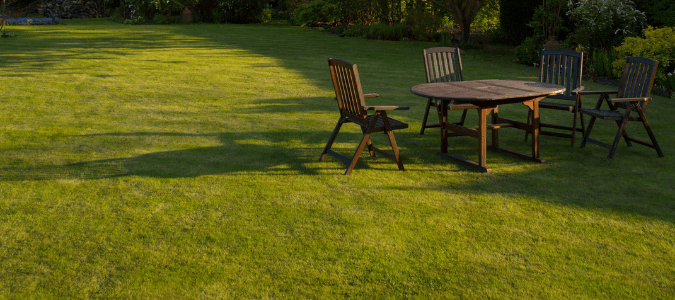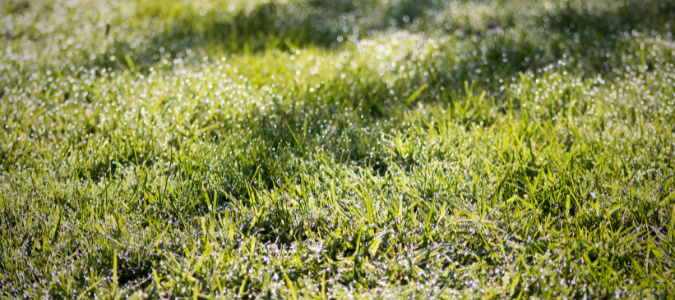Want to know the first step to growing that lush, perfect lawn you’ve always dreamt of? It’s knowing what kind of grass you have, and how to take care of it. With more than 12,000 species of grass grown worldwide, and dozens of regional varieties in every U.S. state, it can be more difficult than it sounds.
But it doesn’t have to be a guessing game.
Nearly all perennial grass found in U.S. lawns across the fall into one of two categories: cool-season grasses and warm-season grasses.
Cool Season Grasses
- Fescues: Fescue grass features shiny, wide, dark green and finely featured blades. Fescues thrive in shaded areas. They need less direct sunlight than other grass breeds, making them ideal for regions that have frequent cloud cover. Fescue is a popular addition in seed blends designed for densely shaded lawns.
- Bluegrass: Bluegrass comes in two varieties: rough bluegrass and the popular Kentucky bluegrass. With distinct V-shaped blades, bluegrass is a densely growing, aggressive and hearty breed. It responds best to full sunlight and thrives in cold climates. Bluegrass seeds are often included in mixes designed for both sun and shade.
- Ryegrass: Ryegrass blades are narrow, shiny and bright green. It is one of the fastest species to germinate. It is often used to establish new lawns in northern regions and to overseed established lawns in southern ones. A fine-textured grass, Ryegrass thrives in cooler but still humid climates. It is resistant to fungus and other lawn diseases that can be prevalent in those areas.
Warm Season Grasses
- St. Augustine: A dark-green grass with thick, rounded blades and a rough texture, St. Augustine is distinguishable by its thick, dense, carpet-like growth and thrives in a wide range of soil types. This is type of grass thrives in full sun, but will also tolerate partial sun. It is commonly used for pastures and ranchlands. It has also become a popular lawn grass in the south.
- Bermuda: Easy to identify by its texture and above-ground root systems, Bermuda grass has fine hairs on its blades. The deep roots of Bermuda grass make it exceptionally heat and drought-tolerant. It has become a common and popular warm-season lawn grass for areas in direct sunlight with good drainage.
- Zoysia: This grass forms a thick, prickly carpet of lawn. Zoysia is a slow-growing grass and it can take up to a year for a new lawn to become established. What’s great about this warm-season grass is that it is relatively tolerant of the cold and can handle light shade. It can also handle high heat and drought conditions. During the zoysia growing season, it is typically light to medium green, and then turns brown come winter.
Can I Add Grass Clippings to My Compost Pile?
Can I Put Fertilizer on Wet Grass?
You can add fertilizer to wet grass, but there are some precautions that you’ll want to consider before doing so.
Adding fertilizer to wet grass can improve its effectiveness, as long as the grass isn’t saturated or waterlogged. You also have to use a fertilizer that’s meant for dilution.
This is because you need drainage to allow the fertilizer to flow down to the root system where it’s needed. If not, it will float around in a pool of standing water or, worse, drain off into an area where you don’t want it.
If you want to apply fertilizer to wet grass, inspect the area first to make sure it’s damp, but not saturated. A good rule of thumb is that your footprints shouldn’t become little mud puddles as you walk. Typically, it’s best to wait until after the rain or sprinkler stops. This way you can determine the moisture level before application.
Since there are different types of fertilizer, stick with organic fertilizers like compost and manure for wet applications. Even if you over-fertilize, there’s less chance of root damage with these natural substances.
Another reason to avoid adding any type of fertilizer to saturated ground is that there is always a chance that the groundwater could run off into lakes, streams or sources of drinking water, and contaminate them.
Achieving the Healthiest Lawn
For the healthiest lawn, it’s important to meet the specific needs of the species of grass that you’re caring for. And, to do that, you really need to know what species it is.
It may seem difficult to determine exactly what species of grass you have. The process of elimination is actually pretty easy once you realize that all grass definitely does not look the same.
It’s not just about watering and fertilizing. A thriving lawn depends on a myriad of factors including region-specific care, soil quality and modifications based on your specific yard.
Lawn care experts can help achieve better results than most homeowners. They can also help you develop a custom and effective lawn maintenance plan to help keep your lawn at its healthiest the whole year.
Often, if you’re looking to save time, money and stress, hiring a lawn care company for lawn service is the best decision and overall value for your time and money.
ABC Can Keep Your Lawn Green
There’s a lot involved in keeping a lawn green. And, if you don’t know what type of grass you have, maintaining a lush lawn can feel nearly impossible. Instead of playing the guessing game, contact ABC Home & Commercial Services. Our lawn care team is highly knowledgeable and can create a lawn care schedule that works for your lawn. We offer a year-round program that ensures your lawn has everything it needs to thrive. Additionally, we offer landscaping services, so your lawn can get the refresh it needs.



